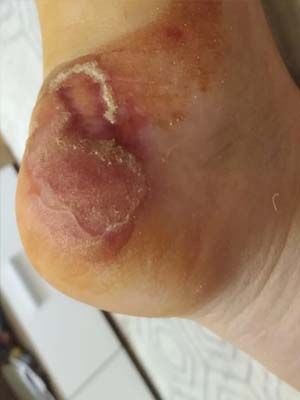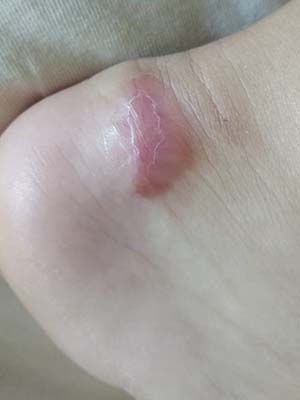- Usage
- Usage Cases
- Scalped heel wound
Case №56
Scalped heel wound
Age of the wound: Соndition after an accident
Regional children’s hospital .Odessa city
-
Patient:
Boy
-
Age:
6 years old
-
Diagnosis:
Scalped heel wound
Types of injuries and types of wounds first aid for injuries, wounds
Wounds - damage to tissues and organs, accompanied by a violation of the integrity of the skin (mucous membrane), accompanying pain, bleeding, dehiscence of the damaged edges (gaping) and dysfunction of the damaged part of the body. Superficial wounds in which incomplete damage to the skin or mucous membrane is observed are called abrasions.
Depending on the presence of the inlet and outlet of the wound channel, wounds are called blind - with a wounding object stuck in the tissues, and through - when it passes through. In addition, there are wounds of soft tissues (skin, subcutaneous tissue, muscles, tendons, blood vessels, nerves), bone damage, as well as wounds that penetrate and do not penetrate into the body cavity. A penetrating wound is a wound when the object that caused it penetrates into the pleural, abdominal, articular, cranial cavities of a person, the eye chamber, etc. With penetrating wounds of the chest and abdominal cavity, damage to the organs located in them is not uncommon.
According to the mechanism of application, the nature of the wounding object and tissue damage, there are cut, stabbed, chopped, bitten, lacerated, scalped, bruised, crushed, gunshot wounds.
A laceration is formed when soft tissues are exposed to a mechanical damaging factor that exceeds their physical ability to stretch. Its edges always have an irregular shape, there are detachments or tears of tissues and destruction of tissue
Chopped wound - a wound caused by a heavy sharp object. It has a greater depth and a greater volume of non-viable tissue than a cut wound.
An incised wound inflicted with a sharp object (knife, glass, etc.) is characterized by the predominance of the length of the damaged area over its depth, smooth edges, a minimum volume of dead tissue and reactive changes around the wound.
A scalped wound is characterized by complete or partial detachment of the skin, and on the scalp of almost all soft tissues, without significant damage to them.
A bruised wound and a crushed wound are possible with blows with blunt objects, characterized by crushing and rupture of tissues with a significant area of primary and subsequently secondary traumatic necrosis with abundant microbial contamination of damaged tissues.
Wounds resulting from serious injuries are dangerous due to the high probability of complications, and also require a long period of rehabilitation. Not all modern wound healing agents and antiseptics are able to guarantee effective tissue repair. The ingress of microbes and long-term disruption of trophic processes often causes amputation of limbs. Modern medicine offers the drug Mirragen, which is unique in its composition and action. It is used as a wound healing agent for severe patients, including those after surgery for wounds and military injuries.
The composition and mechanism of action of Mirragen
Mirragen is a material, not a wound healing or disinfectant liquid. Due to the special structure of its fibers, the action is necessary begins instantly, which is especially important in difficult cases - with chest wounds or for effective wound healing after major operations.Bioactive fibers are extremely small and self-absorbing. In structure, Mirragen resembles a natural fibrin clot that forms in the human body during the normal wound healing process. As a result, a natural matrix is formed in the wound space, which acts as the foundation for natural wound healing and accelerated tissue renewal.
The ability of the material to dissolve is also of clinical importance, since during this process beneficial ions are released into the wound and trauma space, which enhance regeneration at the cellular level. Plus, it eliminates the need to remove material.
When Mirragen matrix enters tissue damaged from penetrating or gunshot wounds, it immediately activates. The matrix interacts with wound fluid, adsorbing pathological secretions. In this case, the appearance of the matrix can change, which is considered absolutely normal.
Cooperate With Us
or via contact phones or email
-
Conveniently
By contacting only one supplier, our customers receive a wide range of products in the shortest possible time.
-
Simple
Our customers are only required to form an order for the supply of products, we will take care of all further tasks
-
Profitable
We save our customers money on import
and delivery taxes



